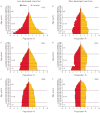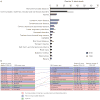Ageing and the epidemiology of multimorbidity
- PMID: 25142482
- PMCID: PMC4918092
- DOI: 10.1183/09031936.00059814
Ageing and the epidemiology of multimorbidity
Abstract
The world's population is ageing and an important part of this demographic shift is the development of chronic illness. In short, a person who does not die of acute illnesses, such as infections, and survives with chronic illnesses is more likely to develop additional chronic illnesses. Chronic respiratory diseases are an important component of these diseases associated with ageing. This article reviews the relationship between ageing and chronic respiratory disease, and also how certain chronic diseases cluster with others, either on the basis of underlying risk factors, complication of the primary disease or other factors, such as an increased state of inflammation. While death is inevitable, disabling chronic illnesses are not. Better understanding of how individuals can age healthily without the development of multiple chronic illnesses should lead to an improved global quality of life.
©ERS 2014.
Conflict of interest statement
Conflict of interest: Disclosures can be found alongside the online version of this article at
Figures









References
-
- US Census Bureau. Global Population at a Glance: 2002 and Beyond. [Date last accessed: April 15, 2014]; www.census.gov/prod/2004pubs/wp02-1.pdf. Date last updated: March 2004.
-
- Wang H, Dwyer-Lindgren L, Lofgren KT, et al. Age-specific and sex-specific mortality in 187 countries, 1970–2010: a systematic analysis for the Global Burden of Disease Study 2010. Lancet. 2012;380:2071–2094. - PubMed
-
- Gutierrez AM, Nobauer K, Soler L, et al. Detection of potential markers for systemic disease in saliva of pigs by proteomics: a pilot study. Vet Immunol Immunopathol. 2013;151:73–82. - PubMed
-
- United Nations. World Population Ageing 2013. [pdf Date last accessed: March 27, 2014]; www.un.org/en/development/desa/population/publications/pdf/ageing/WorldP.... Date last updated: March 2005.
-
- Kinsella K, Phillips DR. Global Aging: the Challenge of Success. [Date last accessed: March 27, 2014]; www.prb.org/pdf05/60.1globalaging.pdf. Date last updated: March 2005.
Publication types
MeSH terms
Grants and funding
LinkOut - more resources
Full Text Sources
Other Literature Sources
Medical
